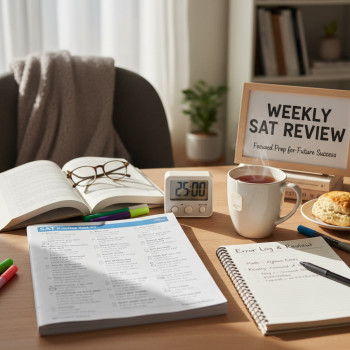Morning vs Evening SAT Practice: Why Your Study Clock Matters
There’s a quiet debate in every high school hallway and online prep group: is it better to study for the SAT in the morning or at night? The truth is a little more nuanced than a single right answer. Your body clock, daily schedule, types of study tasks, and even the Digital SAT format itself all play into what routine will actually move your score upward.
The central question
Are you trying to squeeze every last point out of your study time? Then it pays to be intentional. Some students thrive on a bright, focused morning session. Others do their best work in the calm, late-night hours. The goal of this blog is not to declare a winner but to help you pick—and optimize—the best study window for you.
How time of day affects learning: the science in simple terms
When you study matters because your brain changes across the day. Two big forces are at work: circadian rhythms (your internal clock) and cognitive load (how much mental energy you have left after school, activities, or a job).
Circadian rhythms and peak performance
Most people experience a morning peak in alertness and another smaller peak in the early evening, but individual patterns vary. “Morning people” (larks) feel sharp early; “evening people” (owls) hit their stride later. Matching study tasks to these natural peaks makes learning more efficient.
Cognitive load and study quality
If you spend your day in class, on sports practice, or doing chores, your mental energy might be drained by evening. Conversely, students who spend long hours on screens or extracurriculars may find mornings fresher. The rule of thumb: do your most demanding practice when you have the most focus.
Digital SAT specifics that influence study timing
The Digital SAT is structured differently than the old paper test: it’s adaptive across sections, delivered via the Bluebook platform, and has its own rhythm of sections and timing. Because the test is digital, being comfortable with screen-based practice at the time of day you’ll test matters. If your official test is in the morning, mirror that in practice; if it’s later in the day for a school-administered session, try those hours for practice too.
Why time-of-day practice should match test time
- Familiarity: Practicing at the same time as test day helps condition your alertness patterns and reduces surprises.
- Device comfort: If you test on a school-managed device or Bluebook on your laptop, practicing at that same hour helps you notice technical issues beforehand.
- Stress mapping: Your mental and emotional state at that hour (nervousness, tiredness, hunger) is best simulated during practice.
Morning practice: strengths, weaknesses, and tactics
Morning study sessions have an energy that’s hard to beat: cortisol-driven alertness, fewer distractions, and the psychological payoff of getting hard work done early. For many students, mornings are when tricky reasoning tasks—like complex Reading & Writing passages or multi-step math—are easiest.
Strengths of morning practice
- Higher baseline alertness for many students.
- Less chance of procrastination—practice gets done before the day’s chaos.
- Good for heavy cognitive tasks: problem sets, timed sections, and practice tests.
Limitations of morning practice
- Not ideal if you’re not a natural morning person—cramming then may be inefficient.
- Logistics: early school start times or bus schedules can cut sessions short.
- May feel rushed if you’re balancing other morning commitments.
Morning practice routine that works
- Start with a 10–15 minute wake-up routine: hydration, light movement, and a quick review of flashcards.
- Do your hardest task first: a timed Reading section or a challenging math set for 45–60 minutes.
- Finish with a lighter 15–20 minute recap: error log review or vocab review to consolidate learning.
Evening practice: strengths, weaknesses, and tactics
Evening sessions can be when creativity and integrative thinking shine. After a day of classes, you may find patterns connect more readily. For students who are naturally energized later, evening practice can feel more productive and less rushed.
Strengths of evening practice
- Longer, uninterrupted stretches for deep focus—especially on weekends.
- Opportunity to synthesize the day’s classroom learning with SAT practice.
- Good for review, reflection, and working on endurance with longer practice sessions.
Limitations of evening practice
- Mental fatigue after a full day can reduce the efficiency of intense practice.
- Screen exposure before sleep can disrupt rest, harming next-day performance.
- Late-night cramming is often inefficient and increases stress.
Evening practice routine that works
- Begin with a short active break after school—walk, snack, or nap (20–30 minutes) to reset.
- Do focused practice for 60–90 minutes, prioritizing problem solving or full-section pacing.
- End with lighter tasks and wind-down: reviewing mistakes, setting tomorrow’s goals, and avoiding heavy screen use right before bed.
Which tasks are best for morning vs evening?
Not all practice is equal. Align the task type with your most focused hours to maximize retention and transfer to test day.
| Task Type | Best Time | Why |
|---|---|---|
| Timed full-section practice (Reading/Writing/Math) | Morning | Requires sustained alertness and peak focus; mirrors many test schedules. |
| Deep problem solving (multi-step math) | Morning | High cognitive load benefits from fresher mental resources. |
| Review and analysis of mistakes | Evening | Integration and reflection after a day of learning improves retention. |
| Vocabulary and light drills | Either | Short, low-intensity tasks fit into any part of the day for consolidation. |
| Full practice tests | Match test time (often morning) | Simulating test conditions (time, device, time of day) yields best transfer. |
How to pick the right routine for you
Rather than guessing, test your way to an answer. Two weeks of structured experiments will tell you more than a year of guesswork.
Simple 2-week experiment
- Week 1: Do your main practice block in the morning (45–90 minutes) for five days. Record: focus level (1–5), accuracy, and how tired you feel afterward.
- Week 2: Do the same practice block in the evening. Record the same metrics.
- Compare: Which week produced better accuracy and felt sustainable? Which fit your schedule without stress?
Key metrics to track
- Practice accuracy (percent correct on timed sections).
- Subjective focus and frustration (how clear-headed you felt).
- Retention: Can you redo problems you missed earlier and get them right?
- Sleep quality: Did your practice time affect how long or well you slept?
Practical schedule examples
Here are three sample weekly schedules tailored to common student types. Use them as starting points and tweak for your energy and commitments.
Schedule A: The Morning Maximizer (best for larks and morning test times)
- 6:30 AM — Wake, hydrate, 10-minute light movement.
- 7:00–8:15 AM — Focused Digital SAT practice (timed Reading or Math).
- Evening — 20 minutes of light review or flashcards; no heavy practice within an hour of bed.
Schedule B: The Evening Deep Diver (best for owls and after-school heavy days)
- After school — 30-minute decompress (walk, snack).
- 7:00–8:30 PM — Deep practice session (full section, review mistakes).
- 9:30 PM — Wind-down routine: error log update and planning for next day.
Schedule C: The Split Approach (balanced, for busy students)
- Morning — 20–30 minutes: light drills, vocabulary, or formula review.
- Evening — 60 minutes: timed sections, full problem sets, or practice test segments.
- Weekend — One full-length practice test at test-day time.
How to combine both and avoid common pitfalls
You don’t have to choose one side forever. The most resilient plans combine both times to build skill, endurance, and flexibility.
Smart combination strategy
- Reserve mornings for high-cognitive tasks on weekdays when time is tight.
- Use evenings for review, correction, and synthesis of mistakes.
- Simulate the full test at the time of day you’ll sit for the official exam at least 3–4 times before test day.
Common mistakes to avoid
- Relying on late-night cramming—this lowers retention and harms sleep.
- Practicing at a convenient time that doesn’t match test time—this reduces transfer.
- Ignoring recovery—sleep, hydration, and breaks are part of effective study.
Real-world examples and micro case studies
Meet three fictional but realistic students and how they optimized time-of-day study to improve scores.
Case: Mia — the morning convert
Mia used to cram at night and felt foggy on test day. She switched to morning timed sections three times a week. Within two months she noticed quicker comprehension and fewer careless errors in Reading. Her practice accuracy on Reading rose from 68% to 78% during morning blocks.
Case: Carlos — the evening integrator
Carlos was drained after school but creative at night. He used evenings for review and conceptual math practice, and did one full practice test on Saturday mornings to mimic test day. This combination preserved his energy and improved his endurance—he scored higher on the second half of official practice tests.
Case: Nia — the splitter
Nia had a part-time job and a busy schedule. She did short, high-quality morning drills before school and longer strategic practice in the evening. The split schedule let her maintain consistency without burning out.
How Sparkl’s personalized tutoring can help you optimize timing
Finding your ideal study rhythm is part science, part trial-and-error—and sometimes you need expert help to speed that discovery. Personalized tutoring can tailor both what you study and when you study it.
How tailored tutoring helps
- 1-on-1 guidance to test different schedules and interpret results quickly.
- Tailored study plans that align with your circadian tendencies, school schedule, and test date.
- Expert tutors who model high-quality practice routines and show how to use Bluebook effectively.
- AI-driven insights to identify which time-of-day produces better accuracy and retention for you, and to adjust the plan fast.
If you’re juggling a busy life and want to be efficient, a tutoring partner that personalizes the plan—like Sparkl—can save months of trial-and-error and help you reach peak performance when it counts.
Test-day checklist: align your routine with the exam
Whatever schedule you follow, make sure you match key test-day variables during practice. Repetition under the same conditions is the fastest route to confidence.
- Practice at the same time of day as your real test whenever possible.
- Use the same device and Bluebook settings you’ll have on test day and practice the full sequence (checkout, tools, section navigation).
- Simulate breaks, snack times, and restroom routines to avoid surprises.
- Check sleep quality two nights before the test—avoid late-night heavy studying then.
Quick-reference: Which routine for which student?
| Student Type | Recommended Routine | Why |
|---|---|---|
| Early riser, scheduled morning test | Morning-heavy practice, weekly full tests at test time | Matches natural alertness and the real test environment |
| Evening-focused, busy during the day | Evening deep sessions + one weekend full test at test time | Allows sustained practice when mental energy is highest for them |
| Unpredictable schedule (jobs, sports) | Split schedule with short mornings and evening reviews | Maintains consistency while respecting time constraints |
Final checklist: daily habits that matter more than time of day
Even after you choose morning or evening practice, these habits are the real score-builders:
- Consistency — short daily sessions beat sporadic marathon study.
- Active review — analyze every mistake and turn it into a rule or strategy.
- Mock test fidelity — simulate device, timing, breaks, and environment.
- Sleep and nutrition — treat them like part of your study plan; they directly impact memory and attention.
- Measure and iterate — keep a simple log (time of day, score, focus) and adjust.
Parting thoughts: make the schedule your strength
There’s no universal correct answer to morning vs evening study. The right choice is the one that fits your biology, schedule, and the demands of the Digital SAT. Test both windows, track the outcomes, and then commit to the rhythm that gives you consistent, measurable progress.
And if you want to speed the discovery process, Sparkl’s personalized tutoring—offering 1-on-1 guidance, tailored study plans, expert tutors, and AI-driven insights—can design a time-of-day experiment for you, interpret the results, and build a study routine that turns your unique strengths into real score gains.
Ready to try it?
Pick a two-week experiment, follow one of the sample schedules above, and keep a short log. After two weeks, compare the numbers and your subjective experience. The data will tell a truer story than any study myth. Good luck—and remember: consistency and smart practice beat frantic cramming every time.
















No Comments
Leave a comment Cancel